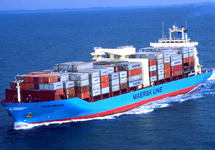 |
 |
|
| eNews • April 2011 | ||
| Promoting a Cost-Effective, Reliable and Competitive Transportation System |
||
 Biggest ships a challenge for U.S. ports
Biggest ships a challenge for U.S. ports
Maersk Line’s order last month for 18,000-TEU ships raises the specter that 12,000-13,000 TEU ships could eventually be “cascaded” into the transpacific trade.
But such behemoths would trigger a whole new set of challenges for terminals on the U.S. West Coast, said speakers at a Trans-Pacific Maritime Conference session on March 8.
Ed DeNike, president of SSA Containers, said such ships will move stacks of containers that are nine-high on deck. “We have 50 cranes on the West Coast and not one can go nine-high,” he observed at the conference organized by the Journal of Commerce. “That means if we want to handle these ships up and down the coast, we are either going to have to raise the cranes or buy new crane. In a lot of cases, the berths can’t support the weight of the new cranes, so it is not just a matter of us buying new cranes, it’s a matter of the port authority realizing the fact that that the majority of container terminal berths may not be able to handle bigger container cranes.”
DeNike said automation and technology make him confident the terminals can handle increased volumes from the ships, but he said railroads would be the determining factor on how much cargo terminals would be able to bring in because the majority of cargo coming into West Coast ports is intermodal.
Michael Journeycake, senior vice president, commercial of GCT Global Container Terminals, which operates two terminals in Vancouver, British Columbia, and two in New York and New Jersey, said if such large ships are put into the transpacific, they would probably have to also operate with rotations that call at a limited number of ports or have additional vessels in a string to maintain a competitive transit time from Asia, because the ships might take four and a half days to load and discharge.
Jim Newsome, president and chief executive officer of the South Carolina State Ports Authority, said East Coast ports are beginning to see 8,000-TEU ships and a 9,000-TEU ship is expected in late April.
“The surprise for me is those ships are coming now in advance of the expanded Panama Canal,” he said.
Source: American Shipper
Soy Transportation Coalition |
|
